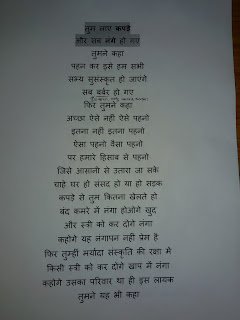Comparision of Hamlet novel by Shakespeare and movie by Kenneth Branagh
The difference between original play ‘Hamlet’ by Shakespeare and movie by Kenneth Branagh is as below:
a) Some dialogues of the play are very long and hard, those are removed or shortened in the movie.
i.e., Dialogues of Ophelia are shortened in the movie to show her madness effectively.
b) Kenneth Branagh has added some scenes those are not in the original play. We can understand the reason behind it that it’s necessary to maintain the interest of the audience.
i.e., 1. The beginning and the end of the movie with the statue of Old king Hamlet.
2. Horatio was reading a newspaper.
c) The costumes which are used in the movie is not of the time in which the play was written.
i.e., Branagh uses costumes to suggest 19th century but the play is written in 17th century.
My perception about the play, characters and situations:
· Play is an extra-ordinary work of Shakespeare.
· It breaks all the Aristotelian rules of a play.
· Characters of the play are mostly thinkers rather than doers.
· Extreme thinking made them mad it shows the inner conflict of one’s mind.
· Situations are quiet changed from the original play that attracts our attention and keep our interest to watch movie.
I feel aesthetic delight somewhere like..
· When the courtiers were gathered with neatly dressed in a court.
· When Ophelia was wandering outside of the castle with his brother Laertes, whole ground was surrounded with snow.
· Old King hamlet was in his garden sleeping calmly, that garden was beautiful.
· The last scene when Hamlet’s dead body was laying in a grave.
I feel Catharsis in different scenes while watching the movie.
i.e.,
a) When the court was arranged to address the courtiers by the new King Claudius with his wife Gertrude and at last, all the courtiers went out except Hamlet. We pity on the situation of Hamlet who was watching his own mother married with his uncle within the month of his father’s death.
b) Ophelia was insulted by Hamlet when he came to know about her betray towards him.
c) Hamlet was talking to his mother in her bedchamber. Too much emotional scene and expressions of mother-son.
d) Laertes came back and saw her sister’s condition.
e) Last scene when Hamlet was stopping Horatio to commit suicide.
Movie helped me in understanding the play better with these reasons:
a) As a reader of the play I felt that every word of the play is written in poetic form and I read it like a poem rather than dialogues. But when I saw characters speaking their dialogues makes clarity in my mind.
b) While reading, we have to remember every dialogues spoken by a specific character till to the end. Whereas in movie once if we saw persons performing characters, we just remember their names by their faces. So, no need to inculcate again and again their roles in the play.
c) Written form sometimes creates confusion of emotions and expressions. We couldn’t understand the real meaning of some words whereas in movie only concentration of our eyes makes the meaning clear.
d) Reading takes more time in which we have to sit, concentrate and read without interest. But movie takes less time and also interesting to watch.
I like some scenes of the movie by Kenneth Branagh..
i.e.,
a) Blue shining eyes of the Ghost.
b) Ophelia’s childish behavior in her madness.
c) Scene of digging in a graveyard when Ophelia dies. Both diggers were enjoying their work.!!
d) At last, when all persons of royal family die. No one remain to rule over the kingdom.
If I were director of the movie ……….
· I would like to make Hamlet doer, not thinker.
· I would like to make hamlet the King of Denmark.
· I would have chosen a young actor for the role of Hamlet.
· I would like to make happy ending by arranging marriage of Hamlet and Ophelia.
Biginning and the End:
In the beginning and in the end we saw the statue of King Hamlet. In the starting it was a mark of country’s richness, prosperity and wealth. But at the end when it was being broken down shows the demolished empire.
In the play ‘Hamlet’ these approaches are applicable:
a) Historical and Biographical Approach:
Here, Ophelia’s character may be intended to suggest the Earl of Essex, formerly Elizabeth’s favorite.
Another historical figure, the Lord Treasurer, Burghley, has been seen by some in the character of Polonius.
We find some historical reference in ‘Hamlet’. In the play, Hamlet was not given throne after his father’s death because in those days the Danish throne was elective one. The royal council, composed of the most powerful nobles in the land, named the next king.
b) Moral and philosophical Approach:
Here, some critic sees Hamlet’s plight as that of the essentially moral and virtuous intellectual man, certainly aware of the gentlemanly code that demands satisfaction for a wrong, but too much the student of philosophy and the Christian religion to believe in the morality or the logic of revenge. Related to this is the view of Hamlet as a kind of transitional figure, torn between the demands and the values of the Middle Ages and those of the modern world.
c) Psychological Approach:
Jones in his essay ‘Hamlet and Oedipus’ bases his argument on the thesis that Hamlet’s much debated delay in killing his uncle, Claudius, is to be explained in terms of internal rather than external circumstances and that the “play is mainly concerned with a hero’s unavailing fight against what can only be called a disordered mind.”
Norman N. Holland summoned up the reasons both for hamlet’s delay and also for our three-hundred-year delay in comprehending hamlet’s true motives:
1) people over the centuries have been unable to say why hamlet delays in killing the man who murdered his father and married his mother.
2) Psychoanalytic experience shows that every child wants to do just exactly that.
3) Hamlet delays because he cannot punish Claudius for doing what he himself wished to do as a child and, unconsciously, still wishes to do; he would be punished himself.
4) the fact that this wish is unconscious explains why people could not explain hamlet’s delay.
d) Mythological and Archetypal Approach:
As with the Greek tragedies, the story of Hamlet was not the invention of the playwright but was drawn from legend.
One other myth that relates closely to the meaning of Hamlet, the myth of divine appointment. This was the belief that not only had the Tudors been divinely appointed to bring order and happiness out of civil strife but also any attempt to break this divine ordinance would result in social, political, and natural chaos. This Tudor myth reflected in several of Shakespearean plays where interference of divine appointments results in both political and natural chaos. This national myth is, quite obviously, central in Hamlet.
The play’s thematic heart is the ancient, archetypal mystery of life cycle itself.
e) Feminist Approach:
The hero of Hamlet is afflicted with the world’s most famous Oedipus complex.
He is son who must against his ”parents,” Gertrude and Claudius, in order to avenge his father and alleviate his own psychic injury, a symbolic castration. But because his conflict is driven by two irreconcilable father-images, Hamlet directs his fury towards his mother and to a lesser degree, towards his beloved Ophelia.
Hamlet contends with a woman’s body, his mother’s, and he finds its sexual proclivities disgusting, as he rails at her in her chamber. He loathes himself for being born out of the female body, his own sexual conflicts and confused desires threaten him from the unconscious.




Comments
Post a Comment